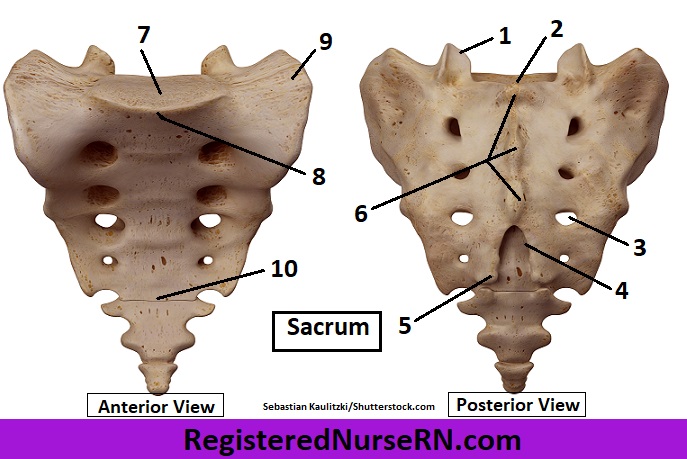This sacrum anatomy quiz will test you over the main structures of the sacrum. The sacrum is located near the inferior portion of the vertebral column. It helps support the weight of upper body, and it connects the vertebral column to the pelvic girdle via the sacroiliac joints.
Prior to watching this video, you might want to review our sacrum anatomy notes, or watch our sacrum anatomy video.
After taking this quiz don’t forget to check out more anatomy and physiology quizzes.
Sacrum Anatomy Quiz

(NOTE: When you hit submit, it will refresh this same page. Scroll down to see your results.)
Sacrum Anatomy Quiz

1. Which structure is depicted in figure 1?
A. Superior articular processes
B. Sacral cornua
C. Sacral promontory
D. Alae
The answer is A, superior articular processes. These articulate (form a joint) with the fifth lumbar vertebra (L5), creating two zygapophyseal joints, which are synovial plane joints.
2. Which structure is depicted in figure 2?
A. Sacral hiatus
B. Sacral foramina
C. Sacral cornua
D. Sacral canal
The answer is D, sacral canal, which is a hollow opening that serves as a continuation of the vertebral canal above, and it houses the sacral nerves.
3. Which structure is depicted in figure 3?
A. Sacral crest
B. Sacral apex
C. Dorsal sacral foramina
D. Sacral hiatus
The answer is C, dorsal sacral foramina. There are four pairs of dorsal foramina and four pairs of ventral foramina, which allow for the passage of sacral nerves.
4. Which structure is depicted in figure 4?
A. Sacral cornua
B. Sacral hiatus
C. Sacral ala
D. Apex
The answer is B, sacral hiatus. Because the inferior spinous process and laminae fail to develop on the lower portion of the sacral bones, an opening is left that resembles a triangle, called the sacral hiatus. Hiatus means gap.
5. Which structure is depicted in figure 5?
A. Sacral apex
B. Ala
C. Sacral cornua
D. Sacral crest
The answer is C, sacral cornua. The word cornua comes from the Latin, and it means horn. So these two sacral cornua are going to articulate (form a joint) with the coccygeal cornua of the coccyx bone.
6. Which structure is depicted in figure 6?
A. Median sacral crest
B. Intermediate sacral crest
C. Lateral sacral crest
D. Sacral apex
The answer is A, median sacral crest. These bumps are the remnants of the spinous process of each sacral vertebra, and they allow for the attachment of the supraspinous ligament. Remember: median is a directional term that means midline, so this is the crest in the midline region of the sacrum.
7. Which structure is depicted in figure 7?
A. Apex
B. Base
C. Ala
D. Lateral part
The answer is B, base. This allows for articulation with that fifth lumbar vertebra via its intervertebral fibrocartilage, creating the lumbosacral joint.
8. Which structure is depicted in figure 8?
A. Ala
B. Apex
C. Hiatus
D. Sacral promontory
The answer is D, sacral promontory, a posterior portion of the pelvic inlet.
9. Which structure is depicted in figure 9?
A. Apex
B. Ala
C. Lateral part
D. Base
The answer is B, ala. The alae (plural) allow for the attachment of muscles and ligaments, and they articulate with the ilium’s auricular surface, creating the sacroiliac joints.
10. Which structure is depicted in figure 10?
A. Base
B. Ala
C. Apex
D. Hiatus
The answer is C, apex, which is the inferior end of the sacrum. Again, apex means “point, and this articulates with the base of the coccyx bone, forming the sacrococcygeal symphysis, an amphiarthrodial joint that allows only slight movement.
11. The sacrum begins as five separate vertebrae, but they later fuse together to form one sacrum bone.
A. True
B. False
The answer is A, true. The sacrum begins as five separate vertebrae, which later fuse into one bone during adulthood. The transverse lines on the anterior surface reveal the points where the individual bones fused.
Don’t forget to tell your friends about this quiz by sharing it your Facebook, Twitter, and other social media. You can also take more fun nursing quizzes.
*Disclaimer: While we do our best to provide students with accurate and in-depth study quizzes, this quiz/test is for educational and entertainment purposes only. Please refer to the latest NCLEX review books for the latest updates in nursing. This quiz is copyright RegisteredNurseRn.com. Please do not copy this quiz directly; however, please feel free to share a link to this page with students, friends, and others.